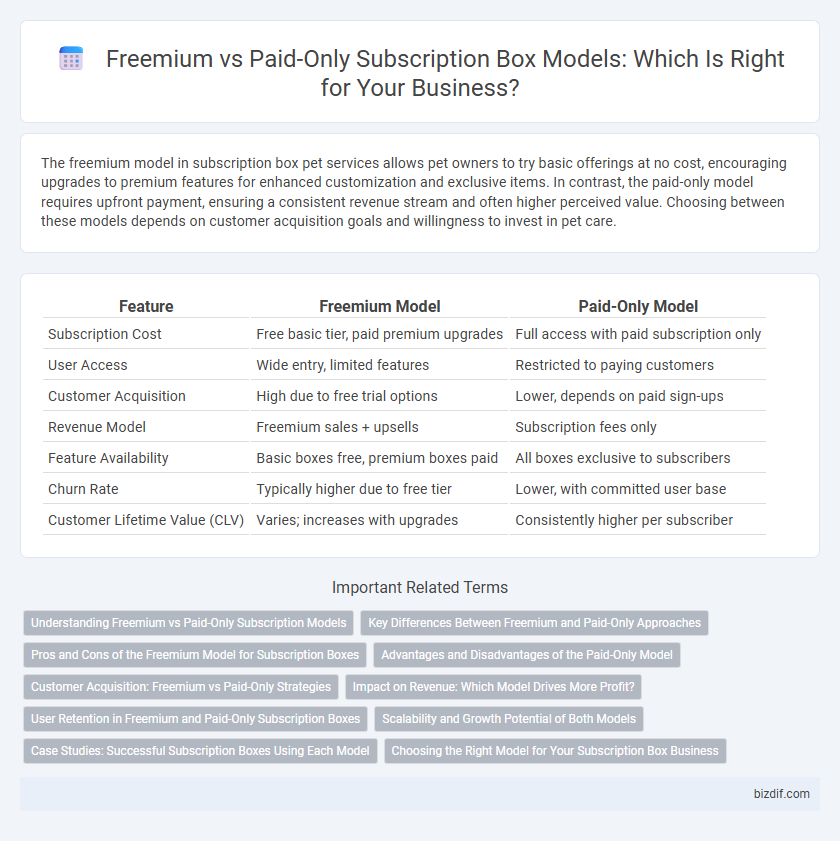The freemium model in subscription box pet services allows pet owners to try basic offerings at no cost, encouraging upgrades to premium features for enhanced customization and exclusive items. In contrast, the paid-only model requires upfront payment, ensuring a consistent revenue stream and often higher perceived value. Choosing between these models depends on customer acquisition goals and willingness to invest in pet care.
Table of Comparison
| Feature | Freemium Model | Paid-Only Model |
|---|---|---|
| Subscription Cost | Free basic tier, paid premium upgrades | Full access with paid subscription only |
| User Access | Wide entry, limited features | Restricted to paying customers |
| Customer Acquisition | High due to free trial options | Lower, depends on paid sign-ups |
| Revenue Model | Freemium sales + upsells | Subscription fees only |
| Feature Availability | Basic boxes free, premium boxes paid | All boxes exclusive to subscribers |
| Churn Rate | Typically higher due to free tier | Lower, with committed user base |
| Customer Lifetime Value (CLV) | Varies; increases with upgrades | Consistently higher per subscriber |
Understanding Freemium vs Paid-Only Subscription Models
Freemium subscription models offer basic access at no cost while charging for premium features, boosting user acquisition and engagement by lowering the entry barrier. Paid-only subscription models require upfront payment, ensuring immediate revenue but potentially limiting initial sign-ups. Understanding the balance between converting free users and maintaining revenue streams is crucial for optimizing subscription box growth and profitability.
Key Differences Between Freemium and Paid-Only Approaches
The freemium subscription box model offers basic products or services for free while charging for premium features or exclusive items, encouraging user trial and gradual conversion. Paid-only models require upfront payment, ensuring immediate revenue but potentially limiting customer acquisition. Key differences lie in user acquisition cost, revenue timing, and customer commitment levels, with freemium models relying heavily on volume and upselling, whereas paid-only approaches depend on immediate customer investment.
Pros and Cons of the Freemium Model for Subscription Boxes
The Freemium model for subscription boxes offers the advantage of attracting a larger user base by providing free introductory products, which can increase brand exposure and customer engagement. However, it may lead to higher acquisition costs and lower immediate revenue compared to the paid-only model, as free users might not convert to paying customers easily. Balancing the costs of free packaging and shipping against potential long-term subscription value is crucial for sustaining profitability in the Freemium approach.
Advantages and Disadvantages of the Paid-Only Model
The paid-only model of subscription boxes guarantees steady revenue and attracts committed customers who value exclusivity and high-quality content. This approach can limit initial user acquisition since potential subscribers cannot experience the product before purchase, potentially increasing churn rates and lowering overall growth. However, it simplifies operations by eliminating the need for managing free tier limitations and upselling, ensuring clearer financial forecasting and resource allocation.
Customer Acquisition: Freemium vs Paid-Only Strategies
Freemium subscription box models attract a broader customer base by offering free entry-level products, encouraging users to upgrade to paid tiers through value demonstration. Paid-only models rely on targeted marketing and perceived product exclusivity to convert prospects directly into paying subscribers, focusing on higher initial revenue. Data shows freemium strategies achieve higher acquisition rates by lowering barriers, while paid-only models benefit from streamlined customer qualification and increased profitability per subscriber.
Impact on Revenue: Which Model Drives More Profit?
The Freemium model generates initial user interest by offering basic subscription boxes for free, increasing customer acquisition and upsell opportunities for premium plans, which can lead to higher long-term revenue. Paid-only models ensure immediate revenue per customer but may limit market penetration and slow subscriber growth. Data shows that while paid-only models yield consistent cash flow, freemium strategies often drive greater overall profit through expanded customer bases and tiered monetization.
User Retention in Freemium and Paid-Only Subscription Boxes
Freemium subscription boxes leverage initial free access to attract users, significantly boosting user retention by allowing trial before commitment, which increases long-term engagement and reduces churn rates. Paid-only models rely on upfront payment, often resulting in lower initial user acquisition but higher immediate revenue per subscriber, although they may experience higher dropout rates due to lack of trial exposure. Data indicates freemium models achieve 30-50% higher retention over six months compared to paid-only subscriptions, making freemium an effective strategy for subscription box services focused on sustained user loyalty.
Scalability and Growth Potential of Both Models
The Freemium model offers higher scalability due to its ability to attract a larger user base with free access, which can be converted into paid subscribers over time, accelerating growth potential. In contrast, the Paid-only model relies solely on direct conversions, limiting initial reach but generating immediate revenue, which can be reinvested into targeted marketing for growth. Subscription box businesses often leverage the Freemium model to maximize user acquisition and long-term profitability, while Paid-only models emphasize sustained cash flow and lower churn rates.
Case Studies: Successful Subscription Boxes Using Each Model
Birchbox exemplifies the freemium model by offering free introductory boxes to attract subscribers, effectively converting them to paid users through personalized beauty samples, driving consistent revenue growth. Dollar Shave Club uses a paid-only model, focusing on monthly razor blade deliveries with straightforward pricing, achieving rapid user acquisition and high retention rates. These case studies highlight how freemium fosters initial engagement while paid-only ensures predictable revenue streams in subscription box businesses.
Choosing the Right Model for Your Subscription Box Business
Selecting the ideal model for your subscription box business hinges on understanding customer acquisition and retention dynamics. The freemium model leverages free entry points to build a broad user base, increasing chances of conversion through value demonstration and upselling premium tiers. Conversely, a paid-only model emphasizes immediate revenue and attracts committed subscribers, streamlining operations by targeting a niche market willing to invest upfront.
Freemium model vs Paid-only model Infographic

 bizdif.com
bizdif.com